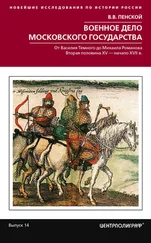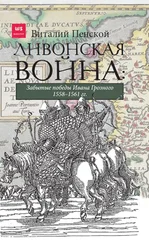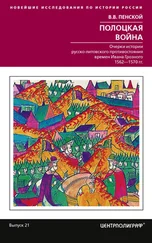Иностранцы о древней Москве. Москва XV–XVII веков. С. 56.
Там же. С. 64.
Перевод наш. — В.П . Оригинал звучит так: «The 12th of December the Emperor’s Majesty and all his nobility came into the field on horseback in most goodly order, having very tine jennets and Turkey horses garnished with gold and silver abundantly; the Emperor’s Majesty having on him a gown of rich tissue and a cap of scarlet on his head, set not only with pearls, but also with a great number of rich and costly stones; his noblemen were all in gowns of cloth of gold, who did ride before him in good order by three and three, and before them there went 5,000 arquebusiers, which went by five and five in a rank in very good order, every of them carrying his gun upon his left shoulder and his match in his right hand, and in this order they marched into the field where the aforesaid ordnance was planted.
And before the Emperor’s Majesty came into the field there was a certain stage made of small poles, which was a quarter of a mile long, and about three score yards off” from the stage of poles were certain pieces of ice of two feet thick and six feet high set up, which rank of ice was as long as the stage of poles; and as soon as the Emperor’s Majesty came into the field, the arquebusiers went upon the stage of poles, where they settled themselves in order. And when the Emperor’s Majesty was settled where he would be, and where he might see all the ordnance discharged and shot off, the arquebusiers began to shoot off at the bank of ice as though it had been in any skirmish or battle, who ceased not shooting until they had beaten all the ice fiat on the ground. After the handguns, they shot off their wild fire up into the air, which was a goodly sight to behold. And after this they began to discharge the small pieces of brass, beginning with the smallest and so orderly bigger and bigger, until the last and biggest.
When they had shot them all off, they began to charge them again, and so shot them all off three times after the first order, beginning with the smallest and ending with the greatest. And note that before they had ended their shooting, the two houses that they shot unto were beaten in pieces, and yet they were very strongly made of wood and filled with earth, being at the least thirty feet thick. This triumph being ended, the Emperor departed and rode home in the same order that he came forth into the field. The ordnance is discharged every year in the month of December, according to the order before mentioned» (The Discovery of Muscovy. From The Collections of Richard Hakluyt. With The Voyages of Othere and Wulfstan from King Alfred’s Orosius. P. 132–133).
См., например: Масса И. Краткое известие о начале и происхождении современных войн и смут в Московии, случившихся за короткое время правления нескольких государей. С. 76; Записки Георга Паерле. С. 285.
Буганов В.И. Документы о сражении при Молодях. С. 171.
Там же. С. 171.
Новый летописец // ПСРЛ. Т. XIV. С. 92.
Флетчер Дж. О государстве Русском. С. 84.
Флетчер Дж. О государстве Русском. С. 84. Оригинал: «This walking or moving Castle is so framed that it may bee set up in length (as occasion doeth require) the space of one, two, three, foure, five, sixe, or seven miles: tor so long it will reach. It is nothing els but a double wall of wood to defende them on both side behind and before, with space of three yards or thereabouts betwixt the two sides: so that they may stande within it, and have roome ynough to charge and discharge their pieces and to use their other weapons. It is closed at both endes, and made with loope holes on either side, to lay out the nose of their piece or push foorth any other weapon… They have also within it divers field pieces, which they use as occasional doth require». (Cм.: Fletcher G. Of the Russe Common Wealth or Maner of Governement by the Russe Emperour (commonly called the Emperour of Muscovia) with the manners and fashions of the people of that country. P. 60–61).
Разрядная книга 1475–1605 гг. Т. II. Ч. II. М., 1982. С. 313.
Буганов В.И. Документы о сражении при Молодях. С. 174–175.
См., например: Разрядная книга 1475–1605 гг. Т. II. Ч. II. С. 331, 312.
Буганов В.И. Повесть о победе над крымскими татарами в 1572 г. С. 271–272.
Корецкий В.И. Соловецкий летописец конца XVI в. // Летописи и хроники. 1980. М. 1981. С. 238.
Там же. С. 238.
Львовская летопись. С. 525.
Московский летописец // ПСРЛ. Т. 34. М., 1978. С. 225.
Буганов В.И. Документы о сражении при Молодях. С. 176.
Мархоцкий Н. История московской войны. С. 44 Оригинал: «Koni pod kazdq choragwi pobitych z postrzelonemi, jako pod ktorq bylo, po 70, po 60, pod drugiemi mniej» (Marchocki M. Historya wojny moskiewskiej. S. 35).
См.: Дополнения к актам историческим, собранные и изданные Археографическою Комиссиею. Т. I. С. 154.
Акты служилых землевладельцев. Т. IV. С. 144.
Там же. С. 131.
Там же. С. 36. Два-три человека на подводу/сани — судя по всему, это была «стандартная» норма отпуска транспорта под скорую перевозку стрельцов и казаков — та же «норма» отпуска подвод есть, к примеру, и в грамоте, выданной муромскому воеводе князю Т.И. Долгорукому в конце 1571 — начале 1572 г. (Акты служилых землевладельцев. Т. IV. С. 87).
См., например: Акты служилых землевладельцев. Т. III. С. 326; Дополнения к актам историческим, собранные и изданные Археографическою Комиссиею. Т. I. С.154–155.
О средней вместимости речных стругов, на которых перевозились стрельцы, позволяет судить свидетельство английского купца и дипломата А. Дженкинсона. По его словам, корабль, на котором он сплавлялся вниз по Волге, сопровождали 2 струга с 50 русскими стрельцами, т. е. один струг вмещал в себя 25 стрельцов ( Дженкинсон А. Путешествие в Персию 1561–1564 гг. // Английские путешественники в Московском государстве в XVI веке. Рязань, 2007. С. 242).
Читать дальше
Конец ознакомительного отрывка
Купить книгу





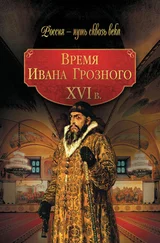
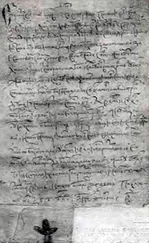
![Елена Арсеньева - Жены грозного царя [=Гарем Ивана Грозного]](/books/311435/elena-arseneva-zheny-groznogo-carya-garem-ivana-g-thumb.webp)

![Виталий Пенской - Полоцкая война [Очерки истории русско-литовского противостояния времен Ивана Грозного. 1562-1570] [litres]](/books/407508/vitalij-penskoj-polockaya-vojna-ocherki-istorii-russko-litovskogo-protivostoyaniya-vremen-ivana-groznogo-1562-1570-litres-thumb.webp)
